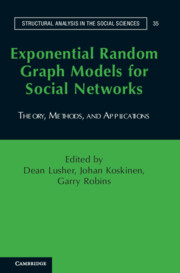Book contents
- Frontmatter
- Contents
- List of Figures
- List of Tables
- 1 Introduction
- Section I Rationale
- 2 What Are Exponential Random Graph Models?
- 3 Formation of Social Network Structure
- 4 Simplified Account of an Exponential Random Graph Model as a Statistical Model
- 5 Example Exponential Random Graph Model Analysis
- Section II Methods
- Section III Applications
- Section IV Future
- References
- Index
- Name Index
5 - Example Exponential Random Graph Model Analysis
Published online by Cambridge University Press: 05 April 2013
- Frontmatter
- Contents
- List of Figures
- List of Tables
- 1 Introduction
- Section I Rationale
- 2 What Are Exponential Random Graph Models?
- 3 Formation of Social Network Structure
- 4 Simplified Account of an Exponential Random Graph Model as a Statistical Model
- 5 Example Exponential Random Graph Model Analysis
- Section II Methods
- Section III Applications
- Section IV Future
- References
- Index
- Name Index
Summary
Exponential random graph models (ERGMs) permit us to examine competing theories regarding the formation of network ties, all within a single analysis. This means that a researcher can test one network theoretical concept for tie formation against another (e.g., Does homophily explain this network, or is it reciprocity?) for their network of interest.
This chapter aims to make the ERGM framework clearer through a simple illustrative example. We only use the terminology introduced in the previous chapters, and leave a full description of the parameters and so on to later chapters in Section II. A more detailed analysis of this example is found in Chapter 13.
Applied ERGM Example: Communication in "The Corporation"
As a practical example of the issues facing social network researchers, we now present the application of ERGMs to the following organizational case study. This example network draws together a number of issues presented so far. The organization of interest is called “The Corporation,” a fictitious name for a real organization in the entertainment industry, which consists of thirty-eight executives. The network under investigation (our “observed network” on which we have collected data) is the “communication network,” which is binary and directed. A tie here represents a response from an actor to a survey item about other executives with whom it was important to communicate to get work completed effectively. The network is depicted in Figure 4.1b. Some basic statistics of the network were presented in Table 4.1.
Information
- Type
- Chapter
- Information
- Exponential Random Graph Models for Social NetworksTheory, Methods, and Applications, pp. 37 - 46Publisher: Cambridge University PressPrint publication year: 2012
Accessibility standard: Unknown
Why this information is here
This section outlines the accessibility features of this content - including support for screen readers, full keyboard navigation and high-contrast display options. This may not be relevant for you.Accessibility Information
- 6
- Cited by
